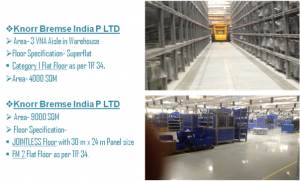An ideal floor would be perfectly flat and level and have no joints.
Floors which support vehicular traffic along paths that are defined and do not change during the life of the floor surface are normally referred to as “Superflat” and are also known as defined traffic floors. Defined traffic normally applies to very-narrow-aisles (VNA) ware-houses in which VNA forklift trucks travel the same path, in the same direction, every day.
This type of most advanced material handling system requires the installation of a very flat (non-wavy and level) floor with controlled accuracy and far much higher tolerances than conventional slabs
High Tolerance is the term referring to surface regularity. Surface regularity needs to be limited in two ways. The floor should have an appropriate flatness in order to limit the bumpiness and general stability in operation of the materials handling equipment, and an appropriate levelness to ensure that the building as a whole with all its static and mobile equipment can function satisfactorily. There are essentially two methods for defining floor flatness requirements. Floors are divided into Free Movement Areas (FM) and Defined Movement Areas (DM).
TR34 Classification FM2 is recommended when specifying a new floor as this represents a good quality floor that can be achieved without excessive cost. For VNA applications a DM Specification (Superflat floor) should be used and the category is defined by the racking height.
We at LTFSPL are proud to deliver Northen India’s First Superflat floor for an area of 4000 SQM for M/s. Knorr-Bremse India Pvt. Ltd. at Faridabad, supporting Wire Guided VNA Equipment
… Delivering Faster – Flatter – Floors for Future!

